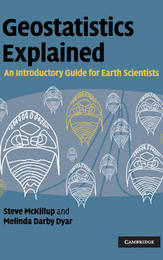
|
Geostatistics Explained: An Introductory Guide for Earth Scientists
Hardback
Main Details
| Title |
Geostatistics Explained: An Introductory Guide for Earth Scientists
|
| Authors and Contributors |
By (author) Steve McKillup
|
|
By (author) Melinda Darby Dyar
|
| Physical Properties |
| Format:Hardback | | Pages:414 | | Dimensions(mm): Height 229,Width 152 |
|
| Category/Genre | Probability and statistics
Earth sciences |
|---|
| ISBN/Barcode |
9780521763226
|
| Classifications | Dewey:550.0727 |
|---|
| Audience | | Tertiary Education (US: College) | | Professional & Vocational | |
|---|
| Illustrations |
Worked examples or Exercises; 93 Tables, unspecified; 110 Halftones, unspecified; 90 Line drawings, unspecified
|
|
Publishing Details |
| Publisher |
Cambridge University Press
|
| Imprint |
Cambridge University Press
|
| Publication Date |
25 March 2010 |
| Publication Country |
United Kingdom
|
Description
A reader-friendly introduction to geostatistics for students and researchers struggling with statistics. Using simple, clear explanations for introductory and advanced material, it demystifies complex concepts and makes formulas and statistical tests easy to apply. Beginning with a critical evaluation of experimental and sampling design, the book moves on to explain essential concepts of probability, statistical significance and type 1 and type 2 error. An accessible graphical explanation of analysis of variance (ANOVA) leads onto advanced ANOVA designs, correlation and regression, and non-parametric tests including chi-square. Finally, it introduces the essentials of multivariate techniques, multi-dimensional scaling and cluster analysis, analysis of sequences and concepts of spatial analysis. Illustrated with wide-ranging examples from topics across the Earth and environmental sciences, Geostatistics Explained can be used for undergraduate courses or for self-study and reference. Worked examples at the end of each chapter reinforce a clear understanding of the statistical tests and their applications.
Author Biography
Steve McKillup is an Associate Professor in the Department of Biosystems and Resources at Central Queensland University. He has received several tertiary teaching awards, including the Vice-Chancellor's Award for Quality Teaching and a 2008 Australian Teaching and Learning Council citation 'For developing a highly successful method of teaching complex physiological and statistical concepts, and embodying that method in an innovative international textbook'. He is the author of Statistics Explained: An Introductory Guide for Life Scientists (Cambridge, 2006). His research interests include biological control of introduced species, the ecology of soft-sediment shores and mangrove swamps. Melinda Darby Dyar is an Associate Professor of Geology and Astronomy at Mount Holyoke College, Massachusetts. Her research interests range from innovative pedagogies and curricular materials to the characterization of planetary materials. She has studied samples from mid-ocean ridges and every continent on Earth, as well as from the lunar highlands and Mars. She is a Fellow of the Mineralogical Society of America, and the author or coauthor of more than 130 refereed journal articles. She is the author of two mineralogy DVDs used in college-level teaching, and a textbook, Mineralogy and Optical Mineralogy (2008).
Reviews'I can highly recommend this book based on my own experience with it, and can also imagine it being very useful for those teaching statistical methods to geoscientists.' Nina Kirchner, Stockholm University '... provides a lifeline for students and researchers across the Earth and environmental sciences who until now have struggled with statistics ... demystifies complex concepts and makes formulas and statistical tests easy to understand and apply.' The Eggs '... reading this book will stop students, researchers and working geologists from using statistics packages as 'black boxes'. There's now no excuse for not having a basic grasp of what you're doing, why you're doing it and how to interpret (but not over-interpret) the results.' Geological Magazine
|